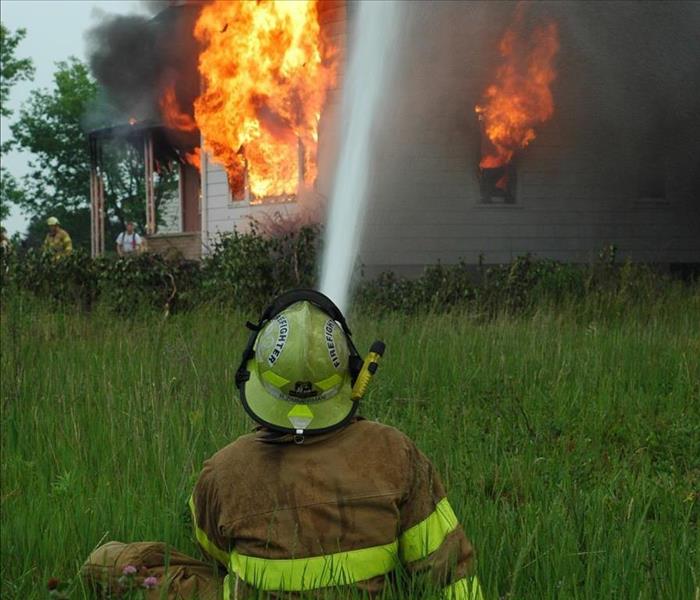Understanding Volts, Amperage and Watts to Prevent Electrical Fires
5/29/2020 (Permalink)
Each year SERVPRO franchises are called in to clean up the aftermath of commercial and residential fires and like the corporate model, we do all we can to, make it "Like it never even happened." Fire damage can have far more ominous and long lasting effect than the water damage restoration services we provide. In addition to structural damage to the property, environmental toxins releases in the air by burning objects, fires sometimes do take lives.
- Electrical Fires in the United States cause $1.3 billion dollars in property damage, 51,000 fires and 500 deaths annually.
- The US Consumer Product Safety Commission claims faulty electrical receptacles as the cause of 5,300 fires annually.
- Electrical Arching, discharge or jump of current on an unintended path to a grounded object, as the cause of 28,000 fires and $700 million dollars in damage annually.
Fire Prevention, beginning with educational awareness and exposure is critical in saving lives and reducing the annual cost of property losses. Understanding the practical relationship of volts, amperage and watts to daily living is essential in preventing and reducing electrical fires.
Appliances and electrical devices are a part of everyday life that functions by plugging the cords into the outlets or receptacles and turning the devices on. How this works is often taken for granted. Being properly educated on the basics of electrical terminology and their practical functionality can save your life and property.
Homes have numerous wires running behind walls from a distribution panel and terminating at a receptacle, switch, or light fixture. Inside the electrical distribution box are circuit breakers or fuses. The circuit breakers or fuses are designed to detect current that exceeds the load capacity of the wire or circuit and to click off or blow to prevent a potential fire. Voltage, Amperage and Watts are the forms of measurement that appliances and electrical devices use; understanding the electrical current draw of each appliance and the load tolerance of each circuit in your home will prevent an overloaded circuit and minimize the risk of a fire.
- Voltage or Volts is an electrical measurement of line pressure. The power or current from the power plant feeds into the home at either 120V or 240V. Most receptacles and household appliances and electronic devices run on 120V. The 240V are reserved for the water heater, dryer and stove.
- Amperage or Amps is a measurement of current flow or pull of current by an appliance or electrical device. Most household wiring or circuits are set to not exceed 15 amps, with the exception of 20 amp circuits in the kitchen for the microwave, 50 amp circuits for the stove and 30 amp circuits for the clothes dryer. All appliances or electrical devices will have a small silver plate on them that tells the amperage or watts pulled by them.
- Watts is a load rating of current pull of electrical devices. Watts can be calculated by multiplying volts by amps. A 15 amp circuit is equivalent to 1800 watts and a 20 amp fuse is equivalent to 2400 watts running on 120V.
It is important to read the label on the back or underside of appliances to understand the current drawn. Too much current drawn through a line causes the wire to overheat and breaks down the insulation on the wire. This can cause faulty wiring that results in a fire. Overloading a circuit with too much current will either trip the breaker or blow the fuse to stop the current flow to minimize damage and prevent a fire. A great resource directory for household appliance wattage can be found at https://generatorist.com/power-consumption-of-household-appliances.
Load capacity on wiring is set to match its tolerance limits. Household wiring that is set for 15 amps is not designed to conduct loads higher than 15 amps. As a general practice it is best not to push the tolerance limits on a circuit. Never under any circumstance replace a circuit breaker or fuse with a one of higher capacity without rewiring the entire circuit for the equivalent tolerance and rating. Failing to do so will result in catastrophic line failure and fire.
- Also never use an extension cord rated less than the amperage or wattage pulled by the electrical device it will be plugged into.
- Replace any frayed cords on appliances or electrical devices.
- If you see sparks cut the power.
- Have an ABC rated fire extinguisher to put out a fire including a Class “C “electrical fire.
- Install and regularly check your smoke detectors.
- Never plug in an appliance or electrical device without knowing your line load.
- If you have experienced a fire and need remediation, call SERVPRO of South Durham and Orange County at 919-596-1242






 24/7 Emergency Service
24/7 Emergency Service
